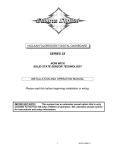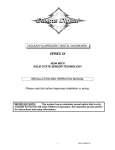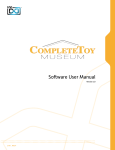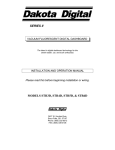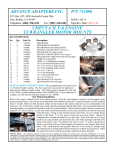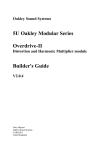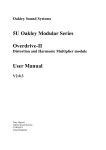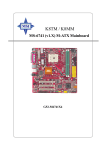Download Dakota Digital 2000 Series Specifications
Transcript
Universal Gear Shift Sender GSS-2000 The easiest system to install and use on the market. The Dakota Digital universal gear shift sender consists of three main components; the sensor, decoder, and mounting brackets. The sensor mounts to the transmission and converts the transmission linkage arm position into an electrical signal. The decoder converts the electric signal from the sensor into the individual outputs for each gear and provides the neutral safety and backup features. The outputs are selectable for positive or negative outputs. This unit can also support single-wire indicators from Dakota Digital, Inc. The mounting brackets attach the sensor to the transmission housing and linkage arm. The only parts of the gear shift sender that are different for the different transmissions are the mounting brackets. The GM 350, 400, and 700-R4 use the same linkage connector and mounting plate, but different holes in the mounting plate. The Ford C-6 and C-4 each have different mounting plates and linkage connectors. For other transmissions, a universal mounting plate is provided. Dakota Digital DIM PARK REVERSE NEUTRAL OVERDRV DRIVE SECOND FIRST 1-WIRE RED GREEN BLACK BACKUP POWER GROUND SAFETY GSS-2000 DECODER Programming LEDs Programming Switch B.U. PWR GND N.S. SW to sensor BLACK wire to sensor GREEN wire to sensor RED wire To back-up lights (optional) fused +12V with key in 'ON' and 'START' positions to Chassis Ground To ECM Park-Neutral input (optional) To neutral safety relay (optional) TYPE OF INDICATOR SYSTEM DIM PARK REVERSE NEUTRAL OVRDRV DRIVE SECOND FIRST INDIVIDUAL PARKING LIGHTS BULBS STR NOT PARK REVERSE NEUTRAL OVRDRV DRIVE SECOND FIRST USED TERMINAL TERMINAL TERMINAL TERMINAL TERMINAL TERMINAL TERMINAL SYSTEM RED WIRE (+) RED WIRE (+) RED WIRE (+) RED WIRE (+) RED WIRE (+) RED WIRE (+) RED WIRE (+) 1-WIRE NOT USED NOT USED DGS-1 PARKING LIGHTS GREEN WIRE (+) GRAY WIRE (+) PURPLE WIRE (+) YELLOW WIRE (+) ORANGE WIRE (+) BLUE WIRE (+) BROWN WIRE (+) NOT USED DGS-2 NOT USED GREEN WIRE (+) GRAY WIRE (+) PURPLE WIRE (+) YELLOW WIRE (+) ORANGE WIRE (+) BLUE WIRE (+) BROWN WIRE (+) NOT USED NOT USED NOT USED NOT USED NOT USED NOT USED NOT USED NOT USED GEAR TERMINAL NOT USED NOT USED NOT USED NOT USED NOT USED NOT USED NOT USED White/Green WIRE NOT USED NOT USED NOT USED NOT USED NOT USED NOT USED NOT USED YELLOW WIRE PURPLE WIRE (-) YELLOW WIRE (-) BLUE WIRE (-) GREEN or WHITE NOT USED VFD/VHX NOT USED SYSTEM ODYR/SLX NOT USED GAUGE DGS-3 NOT USED DGS-4 LOKAR PARKING LIGHTS (- OUT) 1 BROWN or ORANGE WHITE or NOT USED or BROWN ORANGE MAN# 650023B PARTS LIST description gear shift decoder relay for neutral safety gear shift sender with 10’ cable long gear shift sender arm spacer (7/16” hex nut) 5/16” x 1” bolt 5 1/4” rod 4 1/4” rod 3 1/4” rod 1/8” retainer clips for rods GM mounting plate GM linkage connector C-4 mounting plate C-4 linkage connector C-6 mounting plate C-6 linkage connector universal mounting plate quantity 1 1 1 1 2 2 1 1 1 6 1 1 1 1 1 1 1 The neutral safety and backup light features do not have to be connected for gear sender to work. These are optional features provided for vehicles which do not already have these provisions. CONNECTING SENSOR TO DECODER The sensor has a 10 foot gray cable attached to it. This cable contains three wires which connect to the decoder. Connect the RED wire to the terminal marked RED Connect the GREEN wire to the terminal marked GREEN. Connect the BLACK wire to the terminal marked BLACK. CONNECTING TO THE GEAR SHIFT DISPLAY Gear shift displays are not included with the GSS-2000, but it will interface with all of the standard display systems available. Each gear output will provide 12 volts at up to 0.3 amperes or can be programmed to provide grounding outputs. This is enough current capacity for any LED indicator or low power incandescent bulbs. When individual lights are used for each gear, connect the negative wire to ground and the positive wire to the appropriate gear output terminal on the decoder. When using Dakota Digital’s Digital Gear Shift Indicator connect the wires to the decoder according to the instructions provided with the indicator. The GSS-2000 will also work with any Dakota Digital vacuum florescent display system. Connect wires between the decoder and the display system control box. GSS-2000 Specifications SUPPLY Voltage Input (+12) Range 5.6 to 22 V INPUTS DIM Off DIM On DIM < 1.6 V > 4.0 V OUTPUTS Output Current Gear Output < 0.3 A BACKUP < 15 A CURRENT DRAW Park-Neutral Reverse Drive W/O Safety Relay ≈ 30 mA ≈ 80 mA ≈ 20 mA W/ Safety Relay ≈ 160 mA ≈ 80 mA ≈ 20 mA 2 MAN# 650023B PROGRAMMING THE GEARS Programming is done using the set switch, small switch on the decoder located by the sensor connection terminals, and watching the programming LED’s(not visible until power applied) located near each gear output on the GSS-2000. The PARK light is directly behind the PARK terminal, REVERSE light is directly behind the REVERSE terminal, etc. 1. Place the transmission in PARK and make sure the key is off. 2. Press and hold the set switch on the GSS-2000 decoder while turning the key on. 3. The lights should come on either all green or all red. RED is for +12V outputs for Dakota Digital and most other displays. GREEN is for ground outputs for Lokar displays. 4. Press and release the switch to change the output type, toggle from RED or GREEN LEDs lit. Press and hold the switch, for about 4 seconds, until both RED and GREEN LEDs turn on to save the setting. Release the switch and begin gear programming. 5. The PARK lights should be flashing between RED and GREEN. (Transmission should be in PARK) 6. Press and hold the set switch. The PARK light should remain on steady, not flashing. 7. Release the set switch. The REVERSE lights should begin flashing RED and GREEN; The PARK light will go out. 8. Shift the transmission to REVERSE. 9. Press and hold the set switch. The REVERSE light should remain on steady. (If the REVERSE light will not quit flashing, then the sensor is not turning or following.) 10. Release the set switch. The NEUTRAL lights should begin flashing and the REVERSE light will go out. 11. Shift the transmission to NEUTRAL. 12. Press and hold the set switch. The NEUTRAL light should remain on steady. (If the light will not quit flashing, then the sensor is not turning.) 13. Release the set switch. The OVERDRIVE lights should begin flashing and the NEUTRAL light will go out. 14. Shift the transmission to OVERDRIVE. (If you do not have overdrive, then shift to DRIVE.) 15. Press and hold the set switch. The OVERDRIVE light should remain on steady. (If the light will not quit flashing, then the sensor is not turning.) 16. Release the set switch. The DRIVE lights should begin flashing and the OVERDRIVE light will go out. 17. Shift the transmission to DRIVE. (If it is already in drive, then do not move it.) 18. Press and hold the set switch. The DRIVE light should remain on steady. 19. Release the set switch. The SECOND lights should begin flashing and the DRIVE light will go out. 20. Shift the transmission to SECOND. (If you do not have second, then shift to FIRST.) 21. Press and hold the set switch. The SECOND light should remain on steady. (If the light will not quit flashing, then the sensor is not turning.) 22. Release the set switch. The FIRST lights should begin flashing and the SECOND light will go out. 23. Shift the transmission to FIRST. (If it is already in first, then do not move it.) 24. Press and hold the set switch. The FIRST light should remain on steady. 25. Release the set switch. The FIRST light will go out and then come back on steady. 26. Shift the transmission through each of the gears to verify that the programming lights match correctly, turning on steady when in appropriate gear. 3 MAN# 650023B CONNECTING THE NEUTRAL SAFETY RELAY If your vehicle already has a neutral safety switch in the wiring harness to prevent the vehicle from starting while it is in gear, then you do not need to connect this neutral safety switch. Otherwise, cut the wire that goes from your starter switch to the starter solenoid. Connect one end of the wire to the GREEN wire from the relay and connect the other end to the BLACK wire from the relay. For wiring harnesses which provide wires for the neutral safety, connect one side to the GREEN wire and the other side to the BLACK wire. The wire you cut and connect to the relay should provide +12V to the starter solenoid when the ignition switch is in the start position, which engages the starter motor. The WHITE wire from the relay connects to the SAFETY terminal on the decoder. The RED wire connects to the power wire for the decoder. *For the neutral safety switch to operate properly, the POWER terminal on the decoder as well as the red wire on the relay must have power when the key is in both the run and start positions. Ignition Switch Ignition Switch To Ignition Switch Starter Wire Cut wire between starter solenoid and the wire that feeds it from the ignition switch do not connect Wiring SAFTEY relay GREEN 87 BLUE 30 RED 86 85 To POWER terminal on GSS-2000 Decoder (there will be two wires in one terminal at decoder) WHITE To SAFETY terminal on GSS-2000 Decoder BLACK To Starter Solenoid Starter Solenoid Starter Solenoid Typical starter wiring Wiring after SAFTEY relay installed CONNECTING PARK-NEUTRAL SIGNAL TO AN ECM If your vehicle is fuel injected and the ECM requires a signal when the transmission is in either park or neutral, the neutral safety terminal can be used. The SAFETY terminal provides a ground when the transmission is in park or neutral. This can be connected to the ECM in order to pass vehicle inspection. The SAFETY terminal can be used for both a neutral safety and ECM signal at the same time. CONNECTING BACKUP LIGHTS TO THE GSS-2000 If your vehicle already has a backup light switch, then you do not need to connect anything to the BACKUP terminal. If you do not have a backup switch and will be using backup lights on your vehicle, then connect the “hot side” of the backup lights to the terminal marked BACKUP. This circuit is designed to supply +12 V up to 15 amps when the transmission is in reverse. 4 MAN# 650023B MOUNTING SENSOR TO TRANSMISSION. The diagrams on the following pages show the mounting hardware used and mounting location for the most common transmissions. For most applications, the sensor mounts to the side of the transmission using a couple of the transmission pan bolts. A metal plate will attach to the transmission linkage so that it rotates as the transmission is shifted. A rod with a couple of bends in it connects the sensor arm to the plate on the transmission linkage. This allows the sensor arm to move as the transmission is shifted through the gears. Each gear will correspond to a different position for the sensor arm. It does not matter exactly where the sensor arm is when it is in park, first or any other gear. Once the Decoder has been programmed it will remember the positions. The Decoder converts these positions into separate a 12 volt or ground output for each gear. If a Kugel adjustable shifter is being used, you will need a Kugel nut to attach the sensor to the shift linkage. The Kugel nut is available from Dakota Digital, Inc. As the transmission is shifted through all of the gears, the sensor arm should not hit either of its stops, or get ‘bound’ or ‘hung up’. The arm which is mounted on the sender allows for a 1 3/4” throw with the outside hole and 1 5/16” throw with the inside hole. The longer arm which is sent in the kit allows for throws from 3 1/2” with the outside hole to 2 3/16” with the inside hole. When properly adjusted, the sensor arm will move through about 1/2 or more of its full travel. If the sensor arm moves through less than 1/3 of its travel, it may be difficult for the decoder to distinguish between gears. It does not matter which direction the sensor arm turns going from Park to Low. Once the Decoder has been programmed it will read all of the gears correctly. If the typical mounting location for the sensor will not work, the sensor can be mounted anywhere that will allow the sensor arm to move as the gear shift selector moves. The sensor arm can attach either at the transmission linkage or at the gear selector knob or anywhere in between. A universal mounting plate is included to make custom fabrication easier. This plate has several mounting holes for the sensor, but no holes for mounting the plate to the transmission. To use this plate, first determine the best mounting location on your transmission and then mark and drill holes into the universal plate to secure it. In most instances the entire length of the plate will not be needed and it can be cut down using a hack saw or metal shears. Approximate sender mounting location on transmission. When moving or repositioning the sensor arm, be sure the slot in the center of the shaft is aligned with the arm as shown here. 5 MAN# 650023B Mounting to a GM 350, 400, or 700-R4 transmission. 6 MAN# 650023B Mounting to a Ford C-6 transmission Depending on the shifter you are using, you may use the linkage connector provided. The bottom hole is for the sensor rod, the center hole is a pivot point for the connector, and the upper hole connects to the linkage rod. A nylon cable tie can be passed around the linkage connector and transmission shift arm to keep the linkage connector secured tightly. If this does not fit your shifter, then you will need to drill an 1/8” hole into your shift linkage arm to attach the rod to. 7 MAN# 650023B The GM, Ford C-6, and universal mounting plates secure to the transmission oil pan using the supplied 1” bolt, spacer, and washer provided in the kit. On the universal mounting plate, the holes will have to be drilled to line up with the pan bolts being used on the transmission. transmission oil pan Use 3/8" x 1" bolt and 3/8" spacer as shown above to secure mounting plate to transmission. Use 5/16” x 1” bolt and spacer (7/16” nut) as shown above to secure the mounting plate to the transmission Universal mounting plate. This can be used with transmissions for which a specific mounting plate is not provided. 8 MAN# 650023B Mounting to a Ford C-4 transmission This mounting plate connects to the lower two bolts of the four bolt plate located on the left side of the transmission just behind the shift linkage arm. Ford C-4 linkage connector. Depending on the shifter you are using, you may use the linkage connector provided. The bottom hole is for the sensor rod, the center hole is a pivot point for the connector, and the upper hole connects to the linkage rod. A nylon cable tie can be passed through the two side holes and around the linkage connector to keep the linkage connector secured tightly. If this does not fit your shifter, then you will need to drill an 1/8” hole into your shift linkage arm to attach the rod to. STANDARD ARM LONG ARM ARM FLIPPED For the C-4 transmission the arm on the gear shift sender will need to be flipped around so that it rotates on the bottom half. Make sure that the slot in the shaft is in line with the sender arm as shown in the diagram. 9 MAN# 650023B TROUBLE SHOOTING GUIDE Problem Cause None of the lights will come on. Power wire not connected. Ground wire not connected. Always shows the same gear or will not set properly. Indicator lights are all on Except for the correct gear. Reverse and Overdrive lights are on at the same time. Overdrive and Second lights are on at the same time. Overdrive, Neutral, and Drive Lights are flashing. The neutral safety relay And unit just make “clicking” sound. The neutral safety does not allow the starter to engage. Solution Make sure +12 volt wire is connected. Make sure the ground wire is connected to a good ground. Sensor wire not connected. Make sure all three wires from the sensor are connected. Sensor arm not connected. Make sure the sensor arm moves as the gear selector is moved. Sensor linkage connector Make sure the linkage is stuck or bound up. connector and sensor arm move freely as the trans. is shifted through the gears Decoder is set for wrong output Repeat steps 1-4 in Programming the Gears type. on page 3 and select all red lights on. Decoder has not been set. See Programming the Gears section on page 3 of the manual. Decoder is set for wrong output Repeat steps 1-4 in Programming the Gears type. on page 3 and select the opposite light color. (red or green). Sensor ground wire open. Check sensor wire connections. Sensor is moving out of its Loosen sensor arm set screw. Rotate the sensor operating range. shaft so that the slot in the end aligns with the sensor arm. Retighten set screw. (see page 5) Sensor RED wire open. Check sensor wire connections. Sensor signal wire is shorted Check sensor cable. to ground. Sensor is moving out of its Loosen sensor arm set screw. Rotate the sensor Operating range. shaft so that the slot in the end aligns with the sensor arm. Retighten set screw. (see page 5) Decoder settings are incorrect Reprogram the decoder. or have been corrupted. See the Programming The Gears section on page 3. Decoder is losing power Make sure PWR terminal has 12 volts when the key is in both the on and start positions. Decoder is losing power when key is placed in the start position. Make sure PWR terminal has 12 volts when the key is in both the on and start positions. SERVICE AND REPAIR DAKOTA DIGITAL offers complete service and repair of its product line. In addition, technical consultation is available to help you work through any questions or problems you may be having installing one of our products. Please read through the Troubleshooting Guide. There, you will find the solution to most problems. Should you ever need to send the unit back for repairs, please call our technical support line, (605) 332-6513, to request a Return Merchandise Authorization number. Package the product in a good quality box along with plenty of packing material. Ship the product by UPS or insured Parcel Post. Be sure to include the RMA number on the package, and include a complete description of the problem with RMA number, your full name and address (street address preferred), and a telephone number where you can be reached during the day. Any returns for warranty work must include a copy of the dated sales receipt from your place of purchase. Send no money. We will bill you after repair. Dakota Digital Limited Lifetime Warranty DAKOTA DIGITAL warrants to the ORIGINAL PURCHASER of this product that should it, under normal use and condition, be proven defective in material or workmanship for the lifetime of the original vehicle it was installed in, such defect(s) will be repaired or replaced at Dakota Digital’s option. This warranty does not cover nor extend to damage to the vehicle’s systems, and does not cover removal or reinstallation of the product. This Warranty does not apply to any product or part thereof which in the opinion of the Company has been damaged through alteration, improper installation, mishandling, misuse, neglect, or accident. This Warranty is in lieu of all other expressed warranties or liabilities. Any implied warranties, including any implied warranty of merchantability, shall be limited to the duration of this written warranty. No person or representative is authorized to assume, for Dakota Digital, any liability other than expressed herein in connection with the sale of this product. 10 MAN# 650023B










